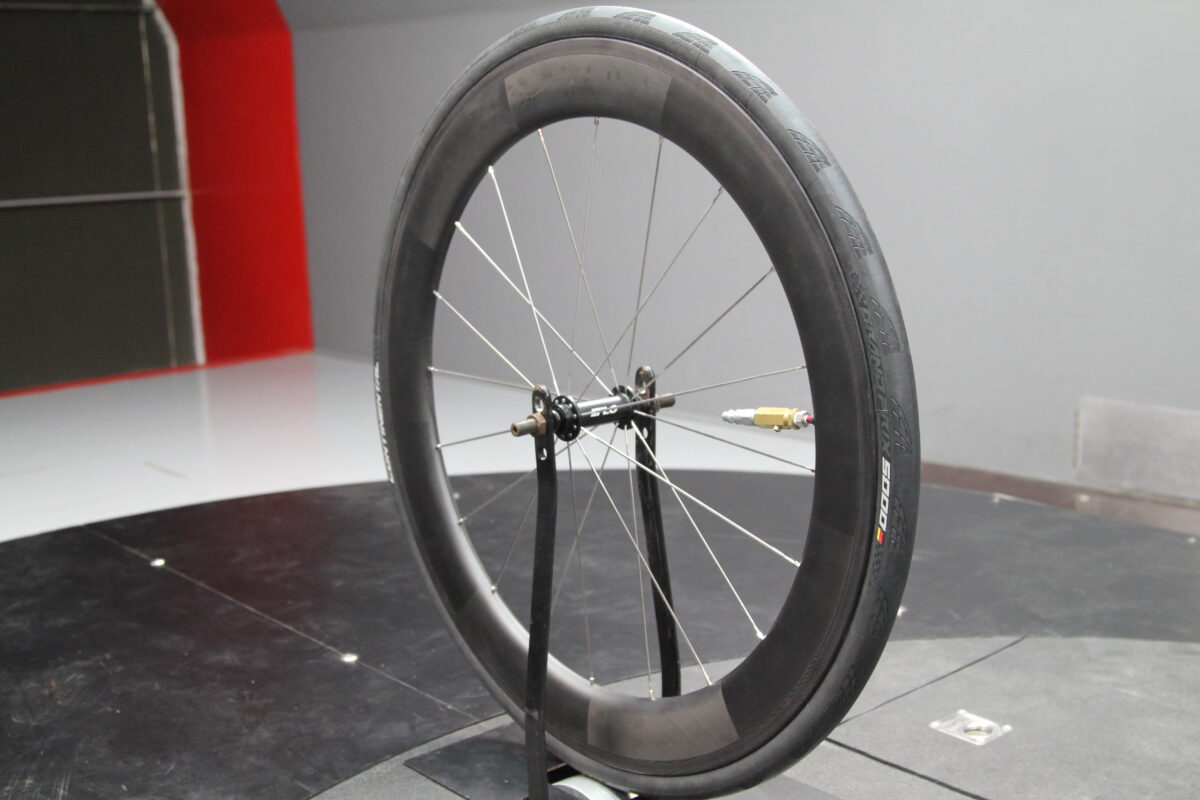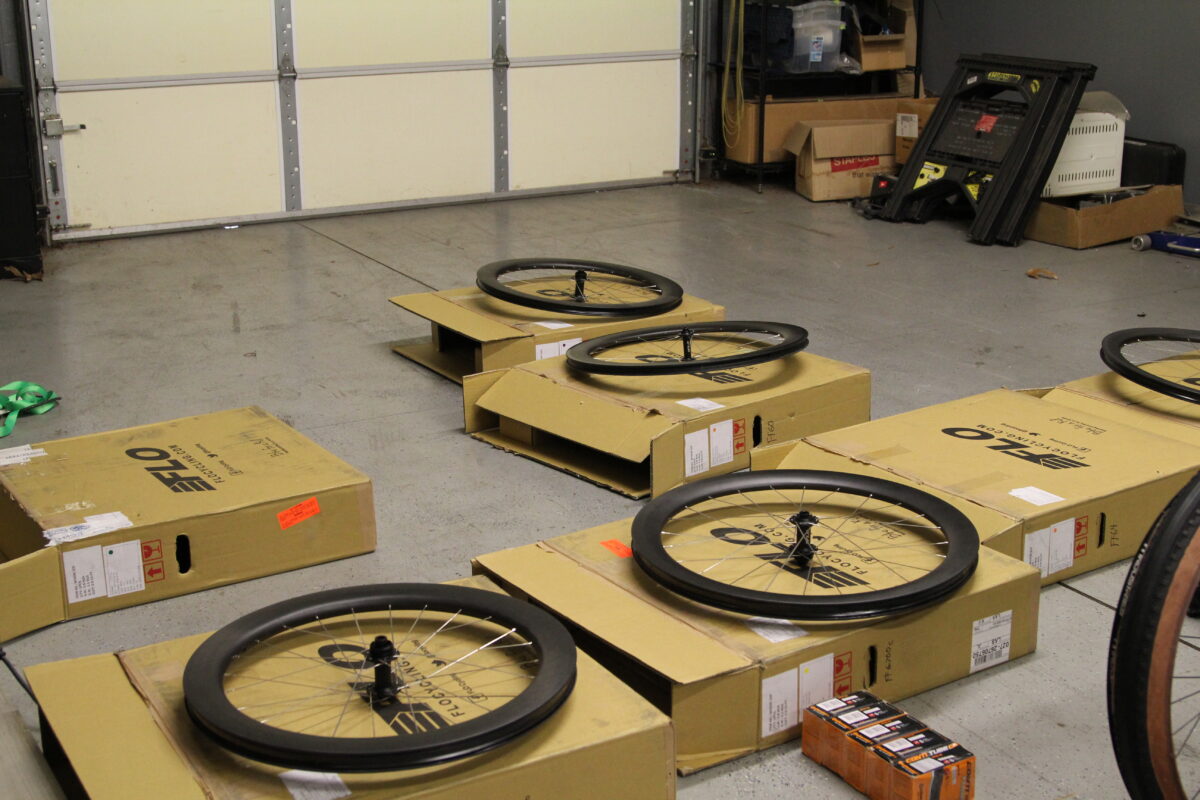The rule of 105 for a cycling wheel states the following:
The Rule of 105 states that the rim must be at least 105% the width of the tire if you have any chance of re-capturing airflow from the tire and controlling it or smoothing it.
This was originally coined by Josh Poertner, who spent many years designing wheels at Zipp. At FLO, we’ve observed the same thing but realized that by following the Rule of 105 can lead to a slower cyclist. Why? Rolling resistance must considered in the equation. When it’s added, breaking the rule of 105 is often faster. Let’s look through the numbers.

Rim Widths and Tire Widths
The table below shows rim width and tire width for the wheel/tire combos. It also shows the percentage of rim width to tire width. It should be noted that the FLO 64 AS and FLO 77 AS are not exactly 105% but very close.
| Wheel Tire Combo | Rim Width (mm) | Tire Width (mm) | Rim Width to Tire Width |
|---|---|---|---|
| FLO 49 AS w/ 25mm Continental GP 5000 | 28.8 | 27.3 | 105.5% |
| FLO 49 AS w/ 28mm Continental GP 5000 | 28.8 | 29.1 | 98.9% |
| FLO 64 AS w/ 25mm Continental GP 5000 | 28.3 | 27.3 | 103.6% |
| FLO 64 AS w/ 28mm Continental GP 5000 | 28.3 | 29.1 | 97.3% |
| FLO 77 AS w/ 25mm Continental GP 5000 | 28.4 | 27.3 | 104.0% |
| FLO 77 AS w/ 28mm Continental GP 5000 | 28.4 | 29.1 | 97.6% |
The Aero Data
The numbers below show the aero watts for the FLO 64 AS with a 25mm Continental GP 5000 and a FLO 64 AS with a 28mm Continental GP 5000 at different yaw angles. These numbers were pulled from a trip to the A2 Wind Tunnel. For those unfamiliar with what these numbers mean, the lower the number the better. When you see a negative number the wheel is actually producing thrust (a propulsion forward/ a push.) For those of you who’ve sailed, this is just like sailing into the wind.
| Yaw Angle | Aero Watts @35km/h |
|---|---|
| 0 | 7.200 |
| 2.5 | 7.073 |
| 5.0 | 6.634 |
| 7.5 | 5.421 |
| 10.0 | 3.939 |
| 12.5 | 1.229 |
| 15.0 | -0.711 |
| 17.5 | -3.265 |
| 20.0 | -2.583 |
| Yaw Angle | Aero Watts @35km/h |
|---|---|
| 0 | 7.298 |
| 2.5 | 6.938 |
| 5.0 | 6.670 |
| 7.5 | 4.999 |
| 10.0 | 3.458 |
| 12.5 | 2.670 |
| 15.0 | 3.917 |
| 17.5 | 3.778 |
| 20.0 | 3.910 |
You can clearly see that the 25mm tire performs better than the 28mm tire. The air stays attached much longer in the 25mm case.
Weight Aero Watts
When working with aerodynamics, we cannot choose the yaw angles we ride, therefore, you are subject to the average yaw angle for your entire ride. In 2015, we became fascinated with this topic and built a computer to measure yaw angles and found a weighting factor for all yaw angles. With that, we can calculate the average aero watts for any wheel. We called this our net drag reduction value. To learn more about this you can check out our blog article on this.
Rolling Resistance Watts
In 2018 we ran 18 months of on-road testinIn 2018, we ran 18 months of on-road testing to prove that a wider internal rim width on a wheel is faster. In that time we solved for the Crr values (or rolling resistance) for a number of tires at different internal rim widths. This allows us to calculate the watts consumed by rolling resistance for a given tire and internal rim width.
Total Power
When you add the aero watts and the rolling resistance watts you get what we call total power. The lowest total power number results in the fastest wheel because it requires the least amount of power from you to move. Remember the goal of a cyclist is to efficiently use the watts you produce to move you forward, making you faster. Any watt consumed by the system reduces your efficiency, thus slowing you down.

The Results
You will see below that if you ignore the rule of 105, every FLO All Sport wheels are faster.
| Wheel Tire Combo | Weighted Aero Watts | Rolling Resistance Watts | Total Watts (Aero + Crr) |
|---|---|---|---|
| FLO 49 AS w/ 25mm Continental GP 5000 | 5.74 | 14.76 | 20.50 |
| FLO 49 AS w/ 28mm Continental GP 5000 | 6.53 | 13.89 | 20.42 |
| Wheel Tire Combo | Weighted Aero Watts | Rolling Resistance Watts | Total Watts (Aero + Crr) |
|---|---|---|---|
| FLO 64 AS w/ 25mm Continental GP 5000 | 5.23 | 14.76 | 19.99 |
| FLO 64 AS w/ 28mm Continental GP 5000 | 5.75 | 13.89 | 19.64 |
| Wheel Tire Combo | Weighted Aero Watts | Rolling Resistance Watts | Total Watts (Aero + Crr) |
|---|---|---|---|
| FLO 77 AS w/ 25mm Continental GP 5000 | 5.02 | 14.76 | 19.78 |
| FLO 77 AS w/ 28mm Continental GP 5000 | 5.46 | 13.89 | 19.35 |
Final Thoughts
The Rule of 105 is a staple and should not be discounted for its importance. Josh Poertner’s works has been, and will continue to be, an important part of cycling history. When selecting a wheel and tire combination, make sure that the design includes both aerodynamics and rolling resistance so you are optimizing your speed. I was shocked when I first realized the impact rolling resistance had on a cycling wheel, which is what lead to the current generation of wheels that optimizes for both aerodynamics and rolling resistance.

Co-founder at FLO Cycling. Jon manages the day to day operations and acts as the lead engineer for all FLO products.
